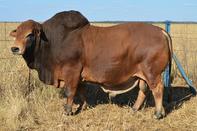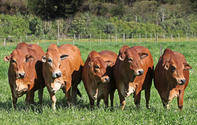The Boran cattle breed developed more than a thousand years ago, from the native short-horned cattle of the Borana people of southern Ethiopia.

The breed, according to DNA analysis, consists of 24% European Bos Taurus, 64% Bos Indicus and 12% African Bos Taurus, which is understandable considering the many different cattle breeds that migrated through Ethiopia to the rest of Africa.
The Kenyan Boran Cattle Breeders Society is credited with developing the “Improved Boran”, which today is used on many farms in South Africa.
Production in South Africa
Kenyan farmer, Miles Fletcher, was the first farmer in the early 1960s to try and take Boran cattle to South Africa. As reported by Boran SA, he moved herds down to Zambia but got stuck there when the then Rhodesian Veterinary Services would only allow him to take progeny of the Boran brought from Kenya through Zimbabwe, which was then known as Rhodesia.
Miles ended up selling the animals to a Zambian farming enterprise, which today still boasts some of the best Boran cattle in that country.
After reading an article on the possibilities of embryo imports at the start of the 1990s, Mile’s great-nephew, Simon Hodgson, took up where his uncle left. He made contact with the Kenyan Boran Cattle Breeders’ Society, who invited him to find a suitable candidate from South Africa to judge the breed at a show in Nairobi.
Douglass Ralfe agreed to act as judge and spent ten days visiting prominent Boran ranches in Kenya during the trip. He became so impressed with the breed that he decided to import genetic material. Boran SA states on its website that Ralfe was especially impressed by the “herd instinct of the cattle, which prevented it from mingling with other herds” and made them very easy to handle.
Attributes

The Boran is a medium-framed breed, with mature cows weighing 380 kg to 450 kg and bulls weighing 500 kg to 850 kg depending on the production environment. Cows have strong maternal traits and produce small calves, so calving problems are almost non-existent.
The cattle can grow quite old, with cows of fifteen years of age still yielding good quality offspring. The cattle vary in colour, from white with spots to brown and red. The coats are relatively loose, with short hair. The breed secretes an oily substance and has an eye bank with long eyelashes and long tail with a big twitch that help to repel insects, such as ticks and flies.
The breed fills the gap between the perfect carcass animal, which requires high maintenance and is expensive to raise and indigenous breeds, which struggle to meet market standards and generate low income from abattoirs. This is because the Boran produces acceptable carcasses, with low to no input costs.
The cattle are also docile, with a strong herd instinct, making them easy to manage and difficult to steal a single animal out of a herd.
Production Regions
The Boran breed, because of its ability to adapt to a wide range of climatic conditions, is produced in all parts of South Africa. Its short shiny coat and excellent heat tolerance allow it to outperform many other breeds in hot humid climates, whereas in winter, it develops a thick loose coat that, along with its oily hair, enables it to withstand extremely cold and wet conditions. Through natural selection, the Boran has also become highly resistant to the effects of internal and external parasites, like ticks.
Use
Boran cattle can be used on their own in closed herds or in crossbreeding programmes, primarily to produce hybrid vigour and enhance meat quality, maternal traits and hardiness of Zebu breeds. The Boran is a non-selective browser and grazer, with a rumen and metabolism that can handle poor roughage.
Meat Quality
The breed’s hardiness makes it possible to “fatten them up” on the land, so they can be truly sold as “grass-fed” and can be successfully fattened off the veld. Trials have also shown that the meat of the Boran and its crosses are consistently better in terms of tenderness and marbling than for any other Zebu Breeds, which are humped cattle that originated in South Asia.
For bulk or Boran Beef export enquiries please use the enquiry link below.